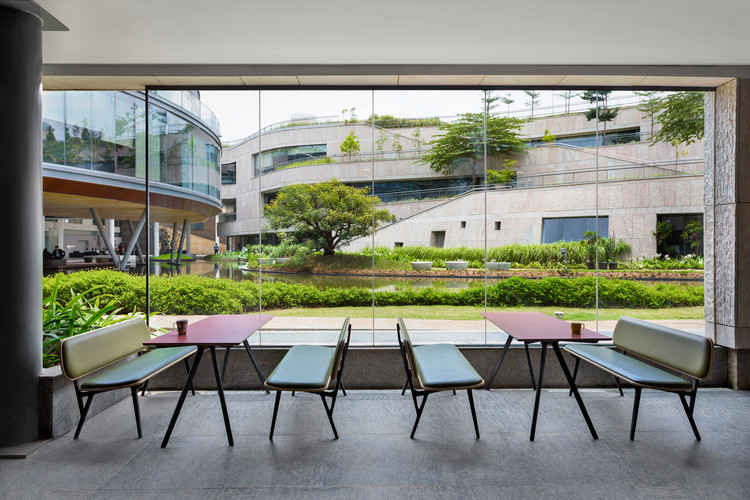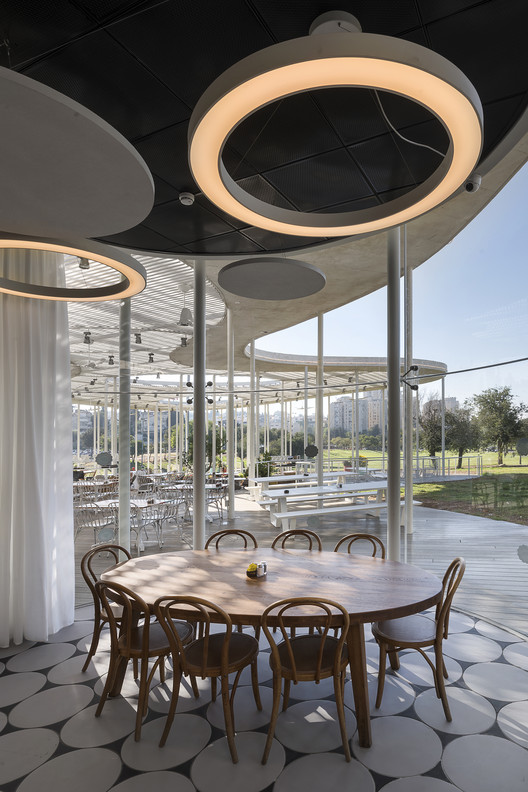ICD Aggregate Pavilion 2018 ICD University of Stuttgart
2018-09-27 03:00
架构师提供的文本描述。在无生命的自然界中,大量的粒状物质,如沙子或砾石,通过永久的侵蚀和增生循环,处于不断形成的过程中。如果架构要模仿这种行为,并允许自己不断地重新配置,该怎么办?
Text description provided by the architects. In inanimate nature, large masses of granular substances, such as sand or gravel, are in constant processes of formation through perpetual cycles of erosion and accretion. What if architecture was to emulate this behaviour and allow for its own continuous reconfiguration?
Text description provided by the architects. In inanimate nature, large masses of granular substances, such as sand or gravel, are in constant processes of formation through perpetual cycles of erosion and accretion. What if architecture was to emulate this behaviour and allow for its own continuous reconfiguration?
ICD聚集展馆2018展示了10年的研究结果,为建筑设计的粒状材料提供了最新的研究结果。它构成了完全由设计的颗粒构成的完全封闭的建筑空间,其仅仅位于松散的摩擦接触中。这种未结合的粒状材料表现出独特的性质,以获得固体材料的稳定特征和流体的快速可重构性。如果部署了定制设计的粒子,则颗粒材料可以形成自支撑空间外壳,同时保持完全可重新配置和可重用。70.000星形,白色颗粒由回收塑料制成。它们被快速部署的大型机器人系统注入。展馆展示了设计的粒状材料是如何为生产形式的去和再稳定的设计范例开辟新的视角,因此,可以快速部署和重新配置的体系结构,以及最终移除和重新使用的体系结构。
The ICD Aggregate Pavilion 2018 presents the latest results of 10 years of research into designed granular materials for architecture. It constitutes the first fully enclosed architectural space entirely constructed from designed granules, which lie only in loose frictional contact. Such unbound granular materials show the unique property to obtain both the stable character of a solid material and the rapid reconfigurability of a fluid. If custom-designed particles are deployed, granular materials can form self-supporting spatial enclosures while remaining fully reconfigurable and reusable. 70.000 star-like, white particles are made from recycled plastics. They are poured by a rapidly deployable, large scale robot system. The pavilion demonstrates how designed granular materials open up a new perspective for a design paradigm of productive forms of de- and re-stabilization and, thus, an architecture that can be rapidly deployed and reconfigured, as well as eventually removed and reused.
The ICD Aggregate Pavilion 2018 presents the latest results of 10 years of research into designed granular materials for architecture. It constitutes the first fully enclosed architectural space entirely constructed from designed granules, which lie only in loose frictional contact. Such unbound granular materials show the unique property to obtain both the stable character of a solid material and the rapid reconfigurability of a fluid. If custom-designed particles are deployed, granular materials can form self-supporting spatial enclosures while remaining fully reconfigurable and reusable. 70.000 star-like, white particles are made from recycled plastics. They are poured by a rapidly deployable, large scale robot system. The pavilion demonstrates how designed granular materials open up a new perspective for a design paradigm of productive forms of de- and re-stabilization and, thus, an architecture that can be rapidly deployed and reconfigured, as well as eventually removed and reused.
© ICD University Stuttgart
设计的粒状材料,ICD聚集体展馆2018年探索了由设计的粒状材料制成的空间围护结构。颗粒材料是由大量颗粒或颗粒组成的物质系统。这些粒子不相互束缚:它们只通过接触力相互作用。自然界的例子是沙子、砾石或雪。在设计的粒状材料中,颗粒是人工制造的,因此它们的几何形状和材料可以由设计者来定义。粒子的设计允许对整体粒状材料的特性进行校准。
DESIGNED GRANULAR MATERIALS The ICD Aggregate Pavilion 2018 explores the construction of spatial enclosures made from designed granular materials. Granular materials are material systems which consist of large numbers of granules or particles. These particles are not bound to each other: they interact only through contact forces. In nature examples are sand, gravel or snow. In a designed granular material the particles are artificially made and consequently their geometry and material can be defined by the designer. Designing the particle allows the calibration of the characteristics of the overall granular material.
DESIGNED GRANULAR MATERIALS The ICD Aggregate Pavilion 2018 explores the construction of spatial enclosures made from designed granular materials. Granular materials are material systems which consist of large numbers of granules or particles. These particles are not bound to each other: they interact only through contact forces. In nature examples are sand, gravel or snow. In a designed granular material the particles are artificially made and consequently their geometry and material can be defined by the designer. Designing the particle allows the calibration of the characteristics of the overall granular material.
© ICD University Stuttgart
ICD聚合亭2018年设计模型使用两种不同性能的设计粒子:能够流动的凸球和高度非凸的六足和可连锁的dekapods。凸球是一种可移动的模板,高度非凸的六足和深六足仍然是一个自支撑的空间结构。这两种类型可以重新使用在一个新的形成,因为粒子是不相互绑定的。因此,在之前的项目中部署的粒子已经完全被用于2018年ICD总展馆。这种高度非凸的六足体是在使用回收塑料的注射成型过程中工业定制的.凸球是现成的可充气的.使用了非常多的这些物质,它们就变成了一种散装材料。作为充气设备,它们具有低包装体积和高可展开体积的额外好处。与高度非凸的六足类和dekapods一样,它们在下一个项目迭代中完全可重用。
DESIGN MODEL The ICD Aggregate Pavilion 2018 uses two types of designed particles with different behaviours: convex spheres, which can flow, and highly non-convex hexapods and dekapods, which can interlock. The convex spheres are a removable formwork, the highly non-convex hexapods and dekapods remain as a self-supporting spatial structure. Both types can be re-used in a new formation as the particles are not bound to each other. Thus, particles deployed in preceding projects have been entirely re-used for the ICD Aggregate Pavilion 2018. The highly non-convex hexapods are industrially custom-made in an injection-moulding process using recycled plastics. The convex spheres are ready-made inflatables. Using a very large number of them they turn into a bulk material. Being inflatables, they have the added benefit of a low packing volume and a high deployable volume. Like the highly non-convex hexapods and dekapods, they are entirely reusable for the next project iterations.
DESIGN MODEL The ICD Aggregate Pavilion 2018 uses two types of designed particles with different behaviours: convex spheres, which can flow, and highly non-convex hexapods and dekapods, which can interlock. The convex spheres are a removable formwork, the highly non-convex hexapods and dekapods remain as a self-supporting spatial structure. Both types can be re-used in a new formation as the particles are not bound to each other. Thus, particles deployed in preceding projects have been entirely re-used for the ICD Aggregate Pavilion 2018. The highly non-convex hexapods are industrially custom-made in an injection-moulding process using recycled plastics. The convex spheres are ready-made inflatables. Using a very large number of them they turn into a bulk material. Being inflatables, they have the added benefit of a low packing volume and a high deployable volume. Like the highly non-convex hexapods and dekapods, they are entirely reusable for the next project iterations.
© ICD University Stuttgart
Diagram © ICD University Stuttgart
由设计的颗粒材料制成的施工过程全尺寸结构需要在现场施工。在这种情况下,粒状材料的工业储存空间被转换为生产大厅。一种可灵活安装的电缆驱动并联机器人,其固定在霍尔的壁和其支撑梁结构上的四个点上。总工作空间约为9至10米。
CONSTRUCTION PROCESS Full-scale structures made from designed granular materials need to be constructed jn situ. In this case the industrial storage space of the granular materials has been converted into a production hall. A cable-driven parallel robot, custom-made to be flexibly installed, was fixed on four points to the walls of the hall and its supporting beam structure. The total working space measures approximately 9 by 10 metres.
CONSTRUCTION PROCESS Full-scale structures made from designed granular materials need to be constructed jn situ. In this case the industrial storage space of the granular materials has been converted into a production hall. A cable-driven parallel robot, custom-made to be flexibly installed, was fixed on four points to the walls of the hall and its supporting beam structure. The total working space measures approximately 9 by 10 metres.
© ICD University Stuttgart
© ICD University Stuttgart
在电缆驱动的并联机器人上,粒状材料的存储盒被用作一个执行器,将它们驱动到一个精确定义的沉积点,并将其卸载。因此,空盒作为边界容器存放在结构的边缘。以这种方式,存储、生产和容器系统也从不是冗余的,而是完全可重用的。
The storage boxes of the granular material are used as an effector on the cable-driven parallel robot, which drives them to a precisely defined deposition point and unloads them. Consequently, the empty boxes are deposited as a boundary container on the edges of the structure. In this manner also the storage-, production- and container-system are never redundant but fully reusable.
The storage boxes of the granular material are used as an effector on the cable-driven parallel robot, which drives them to a precisely defined deposition point and unloads them. Consequently, the empty boxes are deposited as a boundary container on the edges of the structure. In this manner also the storage-, production- and container-system are never redundant but fully reusable.
© ICD University Stuttgart
使用参数化建模环境,通过自定义写入接口控制电缆驱动的并联机器人。设计和构造过程涉及图像分离算法,其允许使用图像分离来检查结构的几何精度。两个互连的拱顶的设计探索了空间外壳的潜力,它们完全由设计的粒状材料以建筑规模形成。
The cable-driven parallel robot was controlled through a custom-written interface using a parametric modelling environment. The design and construction process involved an image-segregation algorithm, which allows to check the geometric accuracy of the structure using image segregation. The design of two interconnected vaults explores the potential of spatial enclosures, formed entirely of designed granular materials at an architectural scale.
The cable-driven parallel robot was controlled through a custom-written interface using a parametric modelling environment. The design and construction process involved an image-segregation algorithm, which allows to check the geometric accuracy of the structure using image segregation. The design of two interconnected vaults explores the potential of spatial enclosures, formed entirely of designed granular materials at an architectural scale.
Architects ICD University of Stuttgart
Location 70469 Stuttgart, Germany
ICD Institute for Computational Design and Construction Karola Dierichs, Achim Menges
Research Team Christian Arias, Bahar Al Bahar, Elaine Bonavia, Federico Forestiero, Pedro Giachini, Shir Katz, Alexandre Mballa-Ekobena, Leyla Yunis, Jacob Zindroski
Photographs ICD University Stuttgart, Roland Halbe
 举报
举报
别默默的看了,快登录帮我评论一下吧!:)
注册
登录
更多评论
相关文章
-

描边风设计中,最容易犯的8种问题分析
2018年走过了四分之一,LOGO设计趋势也清晰了LOGO设计
-

描边风设计中,最容易犯的8种问题分析
2018年走过了四分之一,LOGO设计趋势也清晰了LOGO设计
-

描边风设计中,最容易犯的8种问题分析
2018年走过了四分之一,LOGO设计趋势也清晰了LOGO设计






















































































































